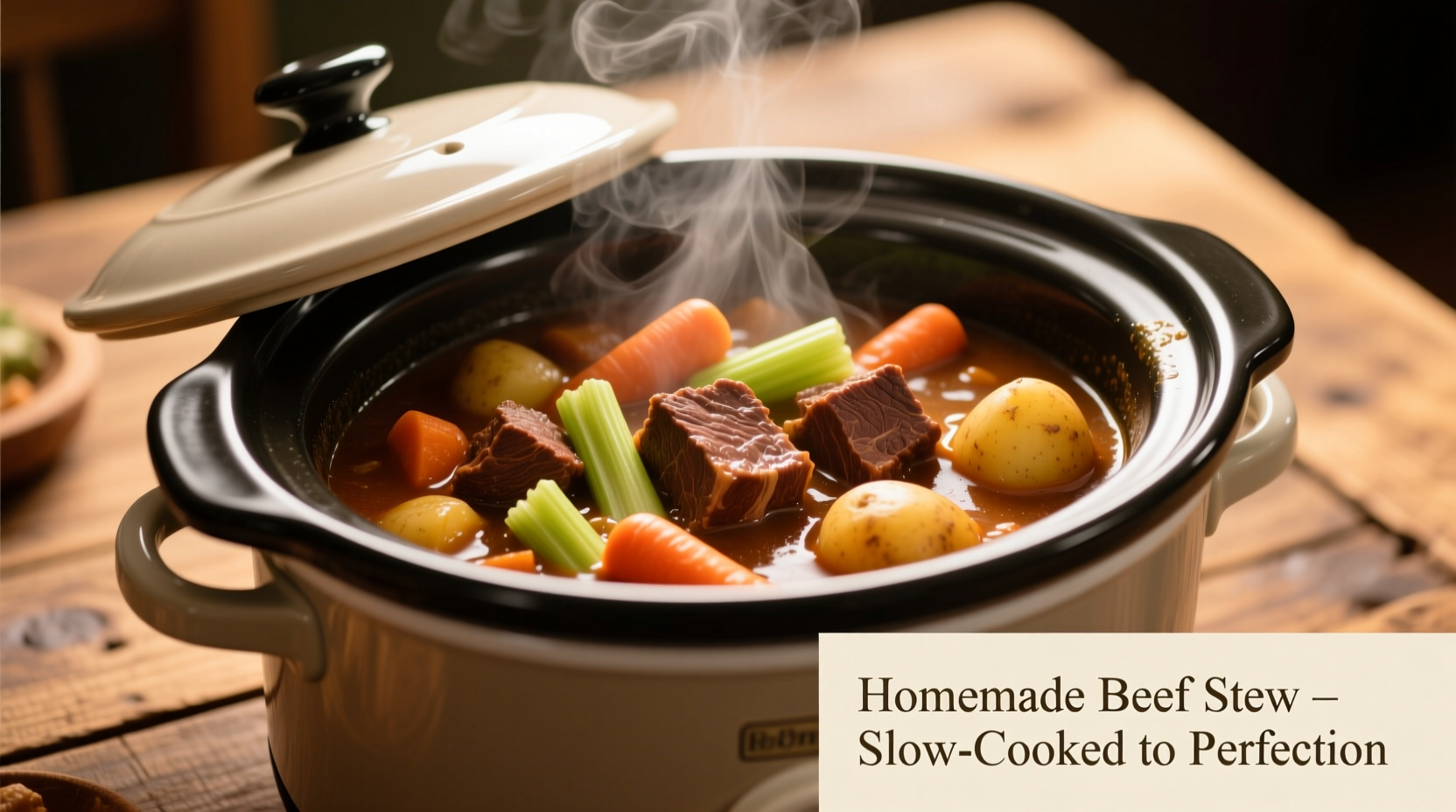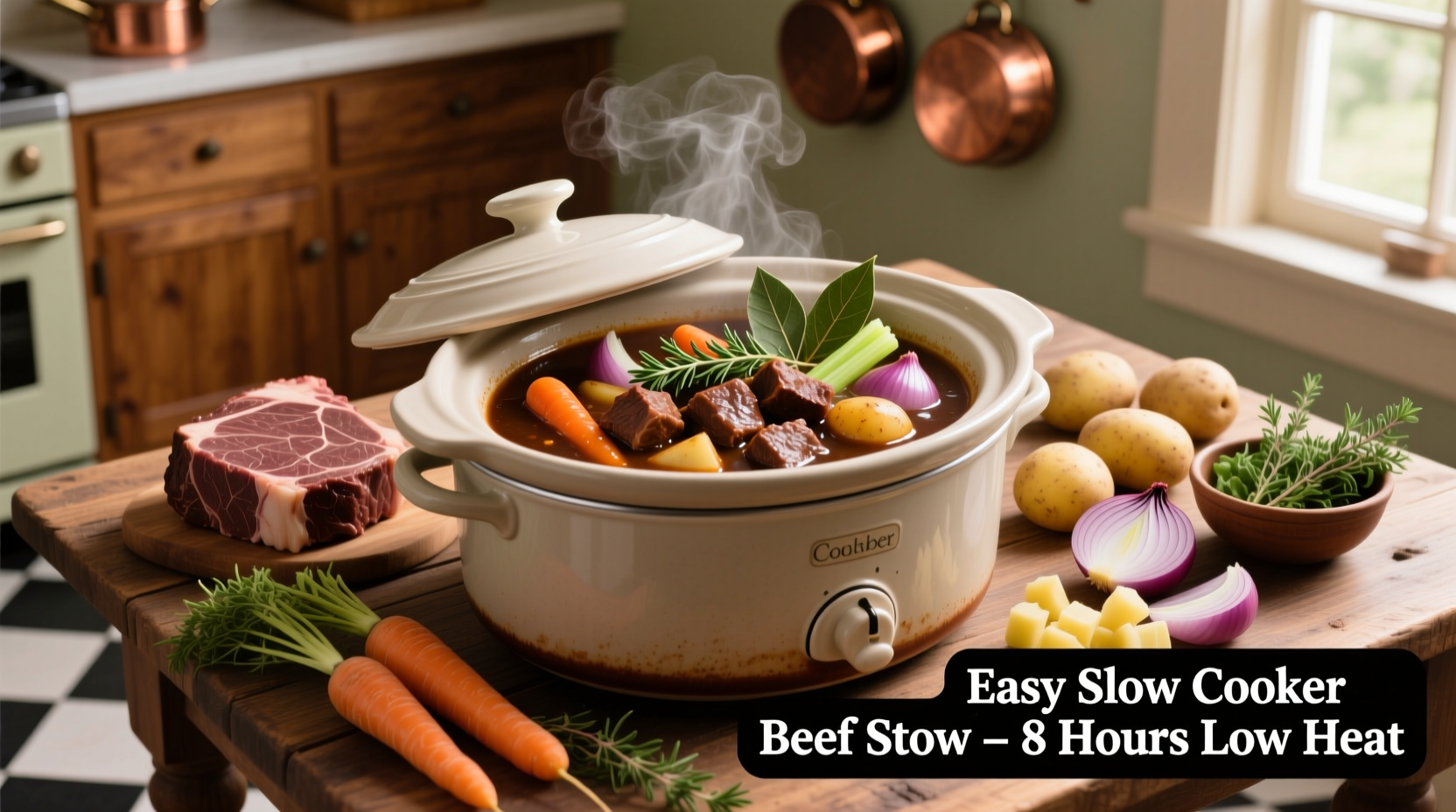There's nothing quite as comforting as a steaming bowl of beef stew on a chilly day. The beauty of using a slow cooker? You get restaurant-quality results with minimal effort—just 30 minutes of prep for 8 hours of hands-off cooking while flavors deepen and tough cuts transform into tender morsels. As a chef who's tested hundreds of slow-cooked dishes, I can tell you this method consistently delivers richer, more complex flavors than stovetop versions because the gentle, even heat breaks down collagen without overcooking vegetables.
Why Slow Cooker Beef Stew Beats Traditional Methods
Slow cooking isn't just convenient—it's scientifically superior for tough cuts like chuck roast. The low temperature (typically 170-280°F) gently breaks down collagen into gelatin over time, creating that luxurious mouthfeel you can't achieve with faster methods. According to USDA food safety guidelines, maintaining temperatures above 140°F for extended periods ensures safety while developing flavor. Unlike pressure cookers that can make vegetables mushy, slow cookers preserve vegetable texture when added at the right time.
Essential Equipment Checklist
Before you start, gather these tools:
- 5-6 quart slow cooker (oval fits meat better than round)
- Cast-iron or heavy-bottomed skillet for browning
- Sharp chef's knife and cutting board
- Wooden spoon for stirring
- Measuring cups and spoons

Ingredient Selection: What Makes This Recipe Shine
Beef selection matters most: Choose well-marbled chuck roast (70% lean minimum) for optimal tenderness. The USDA Meat and Poultry Hotline confirms chuck's higher collagen content transforms beautifully during slow cooking. Avoid lean cuts like sirloin that dry out.
Broth quality impacts flavor depth: Use low-sodium beef broth to control salt levels. For restaurant-quality richness, combine 3 cups broth with 1 cup dry red wine (like Cabernet Sauvignon) which adds complexity through its tannins.
| Cooking Method | Hands-On Time | Total Time | Texture Result |
|---|---|---|---|
| Slow Cooker | 20 minutes | 7-8 hours | Fork-tender beef, intact vegetables |
| Stovetop | 45 minutes | 2-3 hours | Good tenderness, risk of overcooked veggies |
| Pressure Cooker | 25 minutes | 1 hour | Very tender beef, often mushy vegetables |
Your Step-by-Step Cooking Journey
Prep Phase: 20 Minutes That Make All the Difference
Dicing isn't just busywork—uniform 1-inch cubes ensure even cooking. Pat beef dry with paper towels before browning; moisture prevents proper searing. The Maillard reaction (that delicious browning process) requires dry surfaces to create complex flavor compounds. Chop vegetables while meat browns to maximize efficiency.
Browning Technique: The Flavor Foundation
Working in batches to avoid overcrowding, sear beef in hot oil until deeply browned (about 3 minutes per side). Don't stir constantly—let that crust form! This step adds layers of flavor you can't get from dumping raw meat in the slow cooker. As culinary science explains, the Maillard reaction creates hundreds of new flavor compounds that form the stew's flavor base.
Slow Cooker Assembly: Building Flavor Layers
1. Bottom layer: Place browned beef in slow cooker 2. Middle layer: Add onions, garlic, tomato paste, Worcestershire sauce 3. Liquid layer: Pour broth/wine mixture over everything 4. Top layer: Add potatoes and carrots (prevents overcooking) Pro tip: Never fill beyond ⅔ capacity—slow cookers need space for steam circulation. The National Center for Home Food Preservation confirms this prevents unsafe temperature zones.
Cooking Timeline: Patience Pays Off
Set to LOW for 7-8 hours (ideal for texture development) or HIGH for 4-5 hours (acceptable in time crunches). Resist peeking! Each lid lift drops the temperature by 20°F, adding 20+ minutes to cooking time. The Food Safety and Inspection Service states beef stew reaches safe temperatures within 2 hours on low setting.
Finishing Touches: Elevating Your Stew
With 30 minutes left, stir in:
- 1 cup frozen peas
- 2 tbsp chopped fresh parsley
- 1 tsp balsamic vinegar (brightens flavors)
For thicker stew, mix 2 tbsp cornstarch with 3 tbsp cold water and stir in during last 30 minutes. Season with salt and freshly ground pepper—taste before adding salt since broth varies in sodium content.
Troubleshooting Common Slow Cooker Stew Issues
Problem: Beef still tough after cooking
Solution: Extend cooking time in 30-minute increments. Chuck needs 7+ hours on low to fully tenderize. Check your slow cooker's actual temperature with a thermometer—some run cooler than settings indicate.
Problem: Stew too watery
Solution: Remove lid and cook on HIGH for 30-60 minutes to reduce liquid. Alternatively, make a slurry as described in finishing touches.
Problem: Vegetables turned to mush
Solution: Add root vegetables during last 2-3 hours next time. Potatoes and carrots continue cooking even after heat stops.
Storage and Reheating for Maximum Flavor
Beef stew actually tastes better the next day as flavors meld. Store in airtight containers:
- Refrigerator: Up to 4 days
- Freezer: 3 months (leave 1-inch headspace)
Reheat gently on stove over medium-low heat, stirring occasionally. Microwave reheating can make meat rubbery—add a splash of broth to maintain moisture. The USDA FoodKeeper app confirms these safe storage durations for cooked meat dishes.
Perfect Pairings and Variations
Serve with:
- Crusty bread for dipping
- Simple green salad with vinaigrette
- Buttered egg noodles
Variations to try:
- Irish Stout Stew: Replace 1 cup broth with Guinness
- French Bourguignon: Use all red wine with pearl onions and mushrooms
- Smoky Southwest: Add chipotle peppers and sweet potatoes











 浙公网安备
33010002000092号
浙公网安备
33010002000092号 浙B2-20120091-4
浙B2-20120091-4